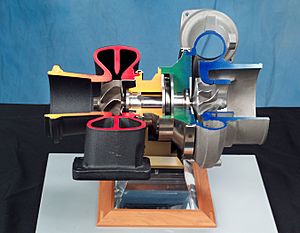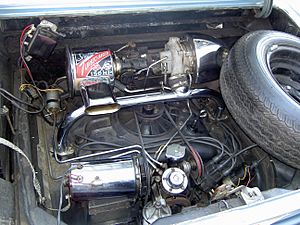Turbocharger facts for kids
A turbocharger, often called a turbo, is a special pump that pushes more air into an internal combustion engine. Think of it like giving the engine a super breath! By forcing extra air in, the engine can burn more fuel. This makes the engine much more powerful. A turbocharger uses a spinning part called a turbine. This turbine is powered by the engine's own exhaust gases, which would otherwise just go to waste. This smart design helps cars and other vehicles go faster and work better.
Contents
What's in a Name?
When turbochargers were first made, people called them "turbosuperchargers". This was because a "supercharger" is another type of air pump for engines. They added "turbo" because it used a turbine. Soon, the name was shortened to "turbocharger".
Sometimes, you might hear "turbosupercharged" used for an engine that has both a supercharger and a turbocharger. This is also known as twincharging.
How a Turbocharger Works
An engine makes power by burning a mix of air and fuel. This mix goes into the engine's cylinders. When it burns, it pushes a part called a piston down. The piston then turns the crankshaft, which creates power. For cars, we measure this power in horsepower.
Engines Without Turbos
An engine that doesn't use a turbocharger or a supercharger is called a naturally aspirated engine. Most car engines are like this. Their power is limited by how much air the pistons can pull into the cylinders on their own.
Turbocharged Engines
A turbocharger is like a small fan that spins very fast. It's powered by the hot exhaust gas leaving the engine. A turbocharger has two main parts: a turbine and a compressor. Both are connected by the same spinning shaft.
The turbine uses the heat and pressure from the exhaust gas to spin. This spinning motion then turns the compressor. The compressor sucks in fresh air from outside. It then squeezes, or compresses, this air. This high-pressure air is then sent into the engine. Because the air is squeezed, more air and fuel can fit into the engine's cylinders. This extra pressure is sometimes called boost pressure. With more fuel to burn, the engine can make much more power and horsepower.
Protecting the Engine
If the air pressure inside the engine's cylinders gets too high, it can damage the engine. To prevent this, a special part called a wastegate is used. The wastegate controls how much exhaust gas goes to the turbine. This stops the compressor from making too much pressure.
A Brief History of Turbos
The turbocharger was invented by a Swiss engineer named Alfred Büchi. He applied for his patent in 1905. Turbochargers started appearing on diesel ships and locomotives in the 1920s.
Turbos in Airplanes
During World War I, a French engineer, Auguste Rateau, put turbochargers on Renault aircraft engines. They worked quite well.
In 1918, an engineer from General Electric, Sanford Moss, tested a turbocharger on an aircraft engine. He did this at Pikes Peak in Colorado, which is very high up. The test showed that turbos could help airplanes keep their power at high altitudes. Engines usually lose power up high because the air is thinner.
Turbochargers were first used in airplanes that were built for sale in the 1930s.
Turbos in Cars
The first truck with a turbocharged diesel engine was built in Switzerland in 1938. The first production cars with turbochargers came from General Motors in 1962. These were the Oldsmobile Cutlass Jetfire and the Chevrolet Corvair Monza Spyder.
In 1974, Porsche showed off its 911Turbo car. This was the first sports car made for sale with an exhaust turbocharger and a pressure regulator (the wastegate).
The first diesel cars with turbos were the Mercedes 300SD and the Peugeot 604, both in 1978. Today, most diesel cars use turbochargers.
Turbos in Racing Cars
Turbocharged engines first found success in racing in 1952. Fred Agabashian used a diesel-powered car with a turbocharger at the Indianapolis 500. He led for a long time before his turbo was damaged.
Turbocharged cars became very popular in races like the 24 Hours of Le Mans from 1976 to 1988, and again from 2000 to 2007.
Formula One racing had a "Turbo Era" from 1977 to 1989. Engines with turbos could make huge amounts of power. Renault was the first to use them in F1 in 1977. Because they were so powerful, other teams started using them too. Eventually, the FIA (the racing rule-makers) decided turbos made the sport too dangerous and expensive. They limited turbo power in 1987 and banned them completely in 1989.
Rally cars, however, still use turbocharged engines. They love the high power these engines can make for their size.
Using More Than One Turbo
Parallel Turbos
Some engines use two turbochargers. Both turbos are usually the same size and smaller than a single turbo. They are often used on V-shaped engines, like V6s and V8s. Each turbo gets power from a separate exhaust pipe. Because they are smaller, they can start boosting power faster. This is called a parallel twin-turbo system. The first car with this setup was the Maserati Biturbo in the early 1980s.
Sequential Turbos
To avoid something called turbo lag (which we'll talk about next), some car makers use two small turbos in a different way. One turbo works all the time. The second turbo only starts working when the engine spins at higher speeds (RPM). Since the turbos are small, they don't have much lag. The second turbo can get up to full speed before it's even needed. This is called a sequential twin-turbo system. Porsche first used this in their 959 car in 1985.
Where Turbos Are Used
Diesel Engines
Turbochargers are very common on diesel engines in cars, trucks, locomotives, ships, and big machines. Diesels are great for turbos for a few reasons:
- Turbos can make a diesel engine much more powerful.
- Truck and industrial diesel engines often run at a steady, high speed. This helps avoid problems like turbo lag.
- Diesel engines don't have a problem called "engine knock." This means they can handle much higher boost pressures from a turbo than gasoline engines can.
Motorcycles
In the 1980s, Japanese motorcycle makers were excited about using turbos to make bikes faster. The 1978 Kawasaki Z1R TC was one of the first. It boosted power quite a bit. However, turbos made motorcycles more expensive. The small increase in speed wasn't worth the extra cost for most people. Since the mid-1980s, no major motorcycle makers have produced turbocharged bikes.
Aircraft Engines
Turbochargers are a natural fit for aircraft engines. As a plane flies higher, the air gets thinner. A turbocharger solves this by squeezing the thin air, making it denser. This helps the engine keep its power even at high altitudes.
Keeping Things Cool
When air is compressed, it gets hotter. This can cause problems for the engine. Hotter air can lead to something called "engine knock" and can't burn as much fuel as cool air. This means less power.
To fix this, the hot air is usually cooled down before it enters the engine. The most common way is to use an intercooler or aftercooler. These devices reduce the air temperature.
Modern turbocharged aircraft usually don't need to cool the incoming air. Their turbos are generally smaller, and the air pressure isn't increased as much, so the air doesn't get too hot.
Turbo vs. Supercharger
A supercharger needs to take some power directly from the engine to run. Even though it uses some power, it adds more power than it takes. A turbocharger, on the other hand, uses the engine's exhaust gases. This is energy that would otherwise just be wasted. So, turbos are often seen as more efficient because they use "waste" energy.
Important Things to Know About Turbos
How Long They Last
Turbochargers can get damaged if the engine oil is dirty or of poor quality. Many car makers suggest changing the oil more often for engines with turbos. Turbos also get very hot when working. It's a good idea to let the engine run for a few minutes at idle before turning it off. This gives the turbo time to cool down, which helps it last longer.
Turbo Lag
Turbo lag is the short delay you might feel when you press the gas pedal in a turbocharged car. It's the time it takes for the turbo to spin up and build enough pressure. This happens because the exhaust system needs a moment to get the turbine spinning fast. A supercharger, which is directly connected to the engine, doesn't have this delay.
Engineers try to reduce turbo lag by using lighter parts, which allow the turbine to spin up faster. Other changes can also help, but they might make the car more expensive.
Images for kids
See also
 In Spanish: Turbocompresor para niños
In Spanish: Turbocompresor para niños









